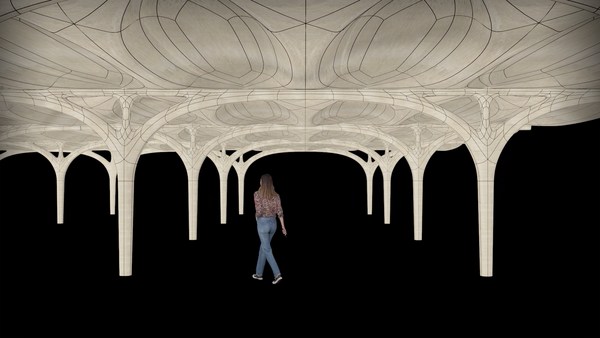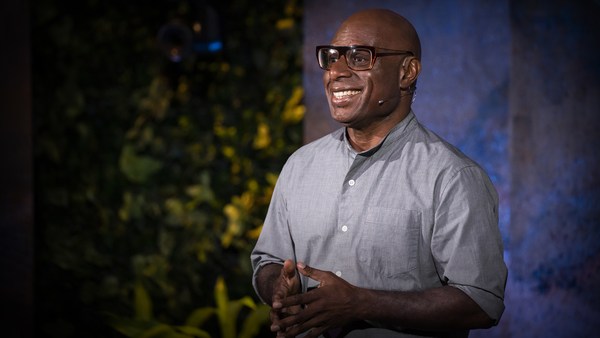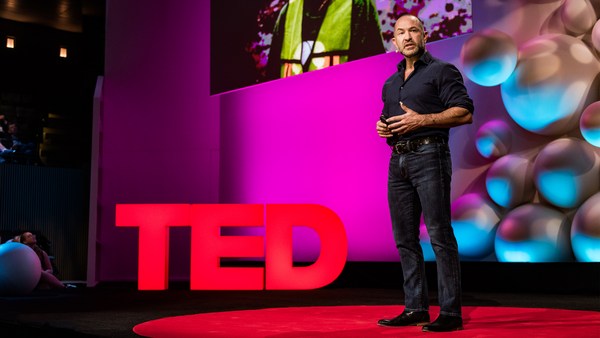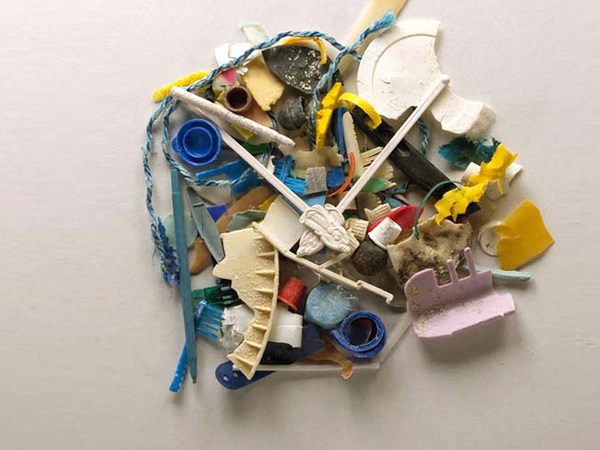The construction industry accounts for 30 to 40 percent of the world's total energy and resources. It also accounts for 40 percent of the world's total carbon emissions.
A man who lived long before us gave us a very simple solution. And he is Mahatma Gandhi, the father of our nation, India. He said that the ideal house should be built with materials found in a five-mile radius around the house. So you think, OK, what is that material? And it is right below our feet. It's mud.
Now imagine, if we can build a house with mud, there would be nothing more sustainable or eco-friendly than that. But then, you might ask, how strong is mud? This compressed five percent cement-added mud block, made by my alma mater, Auroville Earth Institute, is twice as strong as a country fired brick. In fact, it has a dry compressive strength of 6.5 megapascal, as compared to a normal fired-brick, which just has 3 to 3.5 megapascal. But then you may again ask, what about water? Wouldn't water destroy mud brick? This is a brick from the same institute kept in water since 1995, a little less than 30 years, and you can see that it can still hold a significant amount of load.
So what does this tell us? Can we change our perception of construction? Can we imagine a new way of building? Or can we bring beauty to dirt?
I demoted myself from being an architecture graduate to being that of a mason. Or maybe I promoted myself, I don't know. I joined hands with local workers and started teaching them mud techniques. Very soon we started to change every aspect of our construction. Our foundations became poured earth or rammed earth, our walls became mud blocks or compressed earth bricks. Why, even our roofs became domes and vaults made of mud bricks.
This is a brick wall residence called Pirouette House, which we made in a very crowded community. So it goes in a zigzag pattern in need of natural ventilation. Now, please remember that this wonderful parametric form, or curves, were made not with any computational technology, AI or robotic arms. These were actually made with coconut twigs, thread and the masons' bear arms. At a time when the building industry is fast moving towards a future that exceeds mankind, we brought the value of human resources back into it.
But way back in 2012, I was posed with a very life-altering question. I was asked to build a residence, a low-budget, eco-friendly residence for a primary school teacher called Biju Mathew. And when I reached the site, this was what I saw. A mountain of waste and debris dumped by the neighbors after they finished their construction. And because there was no other empty plot.
So what do I do? Do I stand back and allow this waste to be dumped elsewhere? Or do I reimagine the philosophy of building with materials found in my vicinity? Neither me nor the future generations can unsee the waste that is getting piled in our vicinity. Therefore, we decided to use this waste as a part of our construction technique. We hand-pulverized this material, added a bit of soil and again, five-percent cement. And using the techniques we learned so far, we kind of poured it in between two meshes and poured the entire mixture into it. The resultant product was not just a formidable partition. It was load-bearing, means these walls took the load of the entire roof as well.
But this came at a price. I was nicknamed “scrap engineer” by locals who found it amusing to see an engineer search through scrap in the junkyard. But what I found in the junkyard was pure gold: this is discarded electric meter boxes, washing machine wheels, decaying wood, all became part of a new philosophy that included more and more waste.
Thank you.
(Applause)
Now, emboldened by this, our new aim was to build multi-storied mud and waste construction. Is that possible? Yes. This is Shikhara, a three-storeyed multi-story, mud and waste construction. We decided to further modify what we did in the Biju Mathew residence. So instead of using two meshes, we put two wooden shutters and poured the same mixture which we did in the earlier project. And the resultant product was as strong as before and economical too. This wall had a dry compressive strength of 4.5 megapascal. And mind you, this building, this residence, we completed in a meager budget of 90,000 dollars as compared to a general budget of 200,000 dollars or more. Very soon --
(Applause)
Very soon, many practices in the country started adopting this technique, not just because of its eco-friendly part, but also because it was cost-effective.
For us Indians, born to traditional societies, very often, our dreams culminate in lavish weddings and festivals. This, by the way, is a wedding stage. But the very next day, this too, is a common scene. India discards 3.6 million tons of plastic every year. Therefore, we decided to utilize plastic bottles as a part of our construction for a new project called Chuzhi. It's a housing project. And in this project, we started to build circular beams using plastic bottles and reinforced concrete and of course, mud. We started to build it in circles. To be honest, we didn’t know how this would eventually look, but we still kept on building the circles.
(Laughter)
We made it stable and put a roof on top of it. You can see how weird this looks. Chuzhi is a project that resides in a rocky terrain. And it's populated by a lot of trees and shrubs. Now, generally, these two factors are attributed as very bad things for construction. People generally cut trees or clear them to make spaces for their rooms or buildings or whatever. But in here, the trees not only form shelter but also cool the building in a tropical climate. And as far as the terrain was concerned, generally, people would fill it up, level it, clear it and build on top of it. But here, the building is perfectly camouflaged in the rocky terrain, that 10 metres away from this project, you will not see it. That is how good it is camouflaged. In this project --
(Applause)
We managed to use 4,300 plastic bottles which would have otherwise ended up as a landfill or even worse, in the ocean.
One day, we all got sick working at the site. We had breathing difficulty and we kind of went to the doctor. And the doctor very calmly said, "Ah, it must be the burning tires used in road construction. Stay away." And we were shocked. There are hundreds of kids who travel these roads every day to their schools. There are thousands of families who traverse these roads every day to their jobs, why some of us even stay on these roads. And the answer is stay away. Upon further investigation, adding to our worst nightmare, we found out that our country discards half a million tires in a day.
(Audience murmurs)
No, no, I'm not done yet. And the rest of the world discards another half a million tires to India on the same day.
(Audience murmurs)
Yeah. This is an aerial pic of a tire dump, seen from space. This is in a GCC country, that collects the tires from all of you guys, and eventually, dumps it in countries like India. Now you should remember, all of these tires, most of them at least, eventually end up either in the road tarring illegal process or we end up burning it to make again fuel oil, because this is a petroleum product. Now, one way to neutralize this huge toxic threat is to use it as part of construction. Now inspired from architects like Michael Reynolds, we introduced mud and tire to form a new building construction technique. And now we are building residences, we are building museums, schools. And this is the best way to neutralize this threat and create beautiful construction. We believe that tomorrow this may also be the alternative for the housing crisis that is a big reality for many of our underdeveloped countries.
The heart of every project of ours lies with the problems that we created amongst us. Discarded tires, plastic bottles, construction debris. None of these things should be dumped thoughtlessly or carelessly. The world can not just find a solution, but we can even find beauty in this disaster that we created for ourselves.
I remember a single line by the poet of my native language, Ulloor, and it goes like this.
(Speaking Malayalam)
And it translates to this: It is our choice whether to build heaven or hell on Earth.
Thank you, thank you.
(Applause and cheers)





